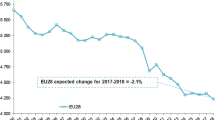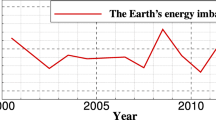Abstract
Discussion on the establishment of an ASEAN Community has intensified in the last 2 decades. The prospect for its establishment is seemingly inevitable with the signing of the so-called Bali Concord II. And so, analytical research on the economic challenges of this political decision is urgently needed. This study addresses issues of the ASEAN integration from an energy policy perspective. It strives to understand the challenges that will be faced by individual members when the ASEAN community is established. The study uses Kaya’s identity method of decomposition to analyze the energy patterns among ASEAN member countries by which energy consumption patterns can be examined, including energy intensity, energy sources, and sectoral energy demands. Analyzing these patterns is needed since a region-wide policy in the energy sector would be futile if it is implemented across the board without country-specific considerations. Cooperation in the energy sector requires great awareness and flexibility if it is to support the goal of an integrated ASEAN.





Similar content being viewed by others
Notes
Referred to as ASEAN countries hereon, taking out Cambodia, Lao PDR, and Myanmar because of data restrictions.
Vietnamese data prior to 1994 are unreliable as energy use from non-fossil fuel is less reliable.
EU-15 is an aggregation of European countries, namely Austria, Belgium, Denmark, Finland, France, Germany, Greece, Ireland, Italy, Luxembourg, the Netherlands, Portugal, Spain, Sweden, and the UK.
The EU-15 is an aggregation of European countries, namely Austria, Belgium, Denmark, Finland, France, Germany, Greece, Ireland, Italy, Luxembourg, the Netherlands, Portugal, Spain, Sweden, and the UK.
References
Adriano JD (2008) Power politics in the Philippines. Asia Times, 10 June 2008
Albrecth J, François D, Schoors K (2002) A shapley decomposition of carbon emissions without residuals. Energy Policy 30:727–736
Ang BW (1994) Decomposition of industrial energy consumption: the energy intensity approach. Energy Econ 16:163–174
Ang BW, Liu F (2001) A new energy decomposition method: perfect in decomposition and consistent in aggregation. Energy 26:537–548
Ang BW, Zhang FQ (2000) A survey index of index decomposition analysis in energy and environmental studies. Energy 25:1149–1176
APERC (2000) Energy efficiency indicators: a study for energy efficiency indicators for industry in APEC economies. Institute of Energy Economics, Tokyo
APERC (2006) APEC energy demand and supply outlook 2006: energy at the Crossroads. Institute of Energy Economics, Tokyo
ASEAN (2008) Overview: energy. Available at: http://www.aseansec.org/6561.htm
ASEAN (2010) ASEAN plan of action on energy cooperation (APAEC) 2010–2015. Available at: http://www.aseansec.org/22675.pdf
Bosseboeuf D, Chateau B, Lapillonne B (1997) Cross-country comparison on energy efficiency indicators: the on-going european effort towards a common methodology. Energy Policy 5:673–682
Boyd GA, Roop JM (2004) A note on the fisher ideal index decomposition for structural change in energy intensity. Energy J 25:87–101
Business Times (2008) Manufacturers asking for lower electricity, gas prices: Malaysia, 7 December 2008
Chertow MR (2001) The IPAT equation and its variants: changing view of technology and environmental impact. J Indus Ecol 4:13–29
Choi K, Ang BW (2003) Decomposition aggregate energy intensity changes in two measures: ratio and difference. Energy Econ 25:615–624
Coalgossip (2008) Malaysia: new electricity tariff rates may increase, 26 June 2008
EIA (2008a) Country analysis briefs: Indonesia. Available at: http://www.eia.doe.gov/emeu/cabs/Indonesia/Oil.html
EIA (2008b) Country analysis briefs: Philippines. Available at: http://www.eia.doe.gov/emeu/cabs/Philippines/Oil.html
Ernsberger D (2007) The strategic challenges for the United States and China in global energy supply. In: Energy perspectives on Singapore and the region. Institute of Southeast Asian Studies, Singapore, pp 197–219
Findlay C, Parsons D, Plunkett H (2007) An assessment of ASEAN’s priority sectors for integration. In: Hew D (ed) Brick by brick: the building of an ASEAN economic community. Institute of Southeast Asian Studies, Singapore, pp 116–130
Freeman SL, Niefer MJ, Roop JM (1997) Measuring industrial energy intensity: practical issues and problems. Energy Econ 25:703–714
Goldemberg J (1996) A note on the energy intensity of developing countries. Energy Policy 24:759–761
Green DJ (2007) Bridging the ASEAN development divide: a regional overview. ASEAN Econ Bull 24:15–34
Herald Tribune (2007) Indonesia tries to shift from kerosene to natural gas for cooking, 10 September 2007
Herald Tribune (2008) Malaysia sticks by fuel price hikes, assures no further increases in near-term, 6 June 2008
Hew D, Soesastro H (2003) Realizing the ASEAN economic community by 2020: ISEAS and ASEAN-ISEAS approaches. ASEAN Econ Bull 20:292–296
Ho AL (2007) Fuel prices up again. Inquirer.net, 19 May 2007
IEA (2007a) Energy balances of non-OECD country: documentation for beyond 20/20 files. Head of Publications Service, Paris
IEA (2007b) Energy balances of OECD country: documentation for beyond 20/20 files. Head of Publications Service, Paris
IEA (2008) Energy prices and taxes. Third Quarter 2008 Database, Paris
Karki SK, Mann MD, Salehfar H (2005) Energy and environment in the ASEAN: challenges and opportunities. Energy Policy 33:499–509
Kawase R, Matsuoka Y, Fujino J (2006) Decomposition analysis of CO2 climate stabilization scenarios. Energy Policy 34:2113–2122
Kaya Y (1990) Impact of carbon dioxide emission control on GNP growth: interpretation of proposed scenarios. Paper presented at the IPCC Energy and Industry Subgroup, Response Strategies Working Group, Paris
Len C (2007) Energy security in Asia: an ASEAN-SCO energy partnership? In: Energy perspectives on Singapore and the region. Institute of Southeast Asian Studies, Singapore, pp 156–175
Leong H (2007) China’s energy security: geo-politics versus interdependence. In: Energy perspectives on Singapore and the region. Institute of Southeast Asian Studies, Singapore, pp 176–196
Leverett F, Bader J (2005) Managing China–US energy competition in the middle east. Wash Q 29:187–201
Liu N, Ang BW (2007) Factors shaping aggregate energy intensity trend for industry: energy intensity vs. product mix. Energy Econ 29:609–635
Lloyd PJ (2005) What is a single market? An application to the case of ASEAN. ASEAN Econ Bull 22:251–265
Lozano S, Gutiérrez E (2008) Non-parametric frontier approach to modelling relationships among population, GDP, energy consumption, and CO2 emissions. Ecol Econ 66:687–699
Ma C, Stern DI (2008) Biomass and China’s carbon emissions: a missing piece of carbon decomposition. Energy Policy 36:2517–2526
Markandya A, Pedroso-Galinato S, Streikmikiene D (2006) Energy intensity in transition economies: is there convergence towards the EU average? Energy Econ 28:121–145
Nakicenovic N (1997) Decarbonization as a long-term energy strategy. In: Kaya Y, Yokobori K (eds) Environment, energy, and economy: strategies for sustainability. United Nations University, New York
Narjoko DA, Amri PD (2007) The development gap between the ASEAN member countries: the perspectives of Indonesia. ASEAN Econ Bull 24:45–71
Naya SF, Plummer MG (1997) Economic co-operation after 30 years of ASEAN. ASEAN Econ Bull 14:117–125
OPEC (2007) World oil outlook 2007. OPEC Secretariat, Vienna
Peng D (2000) The changing nature of east asia as an economic region. Pac Aff 73:171–191
Percebois J (1979) Is the concept of energy intensity meaningful? Energy Econ 1:148–155
Phylipsen GJM, Blok K, Worrell E (1998) Handbook on international comparisons of energy efficiency in the manufacturing industry. Department of Science, Technology and Society, Utrecht University, Utrecht
Raupach MR, Marland G, Ciais P, Quéré C, Canadell JG, Klepper G, Field CB (2007) Global and regional drivers of accelerating CO2 emissions. Proc Natl Acad Sci 104:10288–10293
Reuters India (2008) Malaysia revamps energy price system, risks backlash, 4 June 2008
Salazar LC, Das SB (2007) Bridging the ASEAN development divide: challenges and prospects. ASEAN Econ Bull 24:1–14
Seng KC (2007) The outlook for energy: a view to 2030. In: Energy perspectives on Singapore and the region. Institute of Southeast Asian Studies, Singapore, pp 113–131
Severino RC (2007) The ASEAN development divide and the initiative for ASEAN integration. ASEAN Econ Bull 24:35–44
Sitompul RF (2006) Energy-related CO2 emissions in the indonesian manufacturing sector. University of New South Wales, Sydney
Sun JW (1998) Changes in energy consumption and energy intensity: a complete decomposition model. Energy Econ 20:85–100
Sun JW (2003) Three types of decline in energy intensity–an explanation for the decline of energy intensity in some developing countries. Energy Policy 31:519–526
Symon A (2005) Energy and ASEAN economic integration. In: Heng RH, Sen R (eds) Regional outlook: Southeast Asia 2005–2006. Institute for Southeast Asian Studies, Singapore, pp 80–83
UNDP (2004) World energy demand: overview 2004 update. Bureau for Development Policy, New York
World Bank (2008) World development indicators. Washington, DC
Wu K, O’Kray CR (2007) The implications and impacts of China’s oil demand on the Asia Pacific. In: Energy perspectives on Singapore and the region. Institute of Southeast Asian Studies, Singapore, pp 132–141
Author information
Authors and Affiliations
Corresponding author
About this article
Cite this article
Nurdianto, D.A., Resosudarmo, B.P. Prospects and challenges for an ASEAN energy integration policy. Environ Econ Policy Stud 13, 103–127 (2011). https://doi.org/10.1007/s10018-011-0007-1
Received:
Accepted:
Published:
Issue Date:
DOI: https://doi.org/10.1007/s10018-011-0007-1




